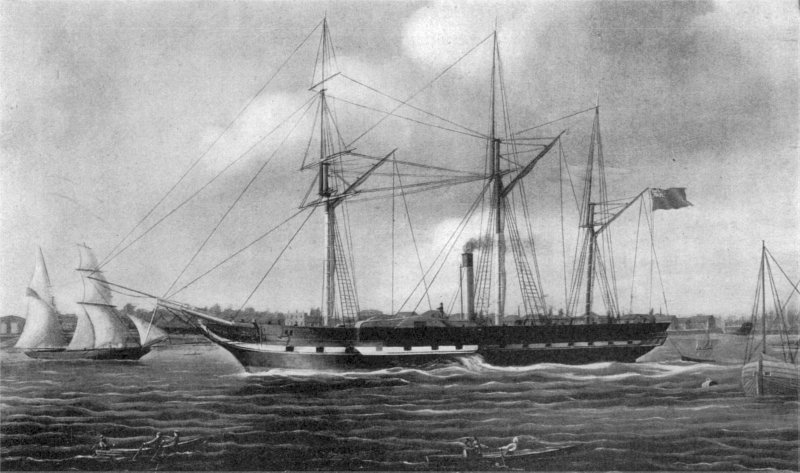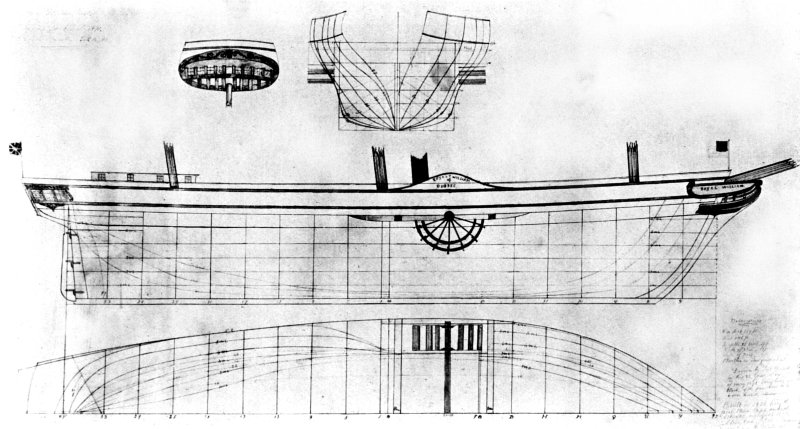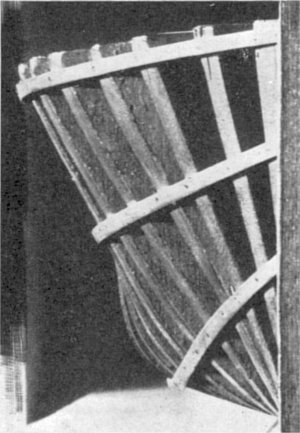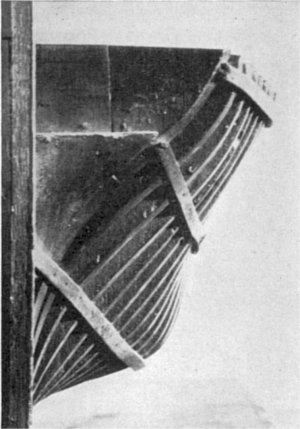The Record-Making Royal William, 1833
SEVEN primary records have combined to make the Quebec-built Royal William quite unique among all the steamships of the Seven Seas. Of these seven primary records two made her unchallengeably first in Canada; three made her equally first in foreign waters; while two more made her first throughout the whole wide world.
The object of this article is not only to mark the centenary of her first world-record-making voyage but also to base her sevenfold claim so safely on the original evidence that all the winds and waves of controversial strife can never shift her cargo of substantiated truth. But while inevitably correcting the innumerable sins, both of commission and omission, in practically all previous accounts, no matter by whom they have been written or by what authorities they have been approved, this article will take equal care to make no amendments whatsoever without giving precisely documented references, either in the text or the little final footnote, to the exact original evidence concerned. Readers can therefore judge for themselves whether we have brought the Royal William's records safe to port, after steering them between the Scylla of those "outsiders" who have hitherto ignored or misinterpreted the substantiated evidence and the Charybdis of those perhaps too pro-Canadian "insiders" who, quite as "queeringly", have hitherto exaggerated all the pros, without, alas, a due examination of the cons.
But, before we clear her decks for action, we had better examine her more celebrated rivals, lest doubting critics should keep asking: – "How about the Savannah, the Enterprise, and Curaçao; the Sirius, Great Western, and the rest?"

The "Royal William" in the Thames; from an oil painting by S. Skillett, 1834. Click for enlargement
Canadians may think it a work of supererogation to disprove these counterclaims again. But we must remember that Canadian publicity was a very small affair, indeed, a hundred years ago, more especially in comparison with the vastly greater publicity emanating from the United Kingdom and United States, which, between them, then possessed far more ocean-going tonnage than all the other countries in the world. Besides, we must likewise remember that neither of the Royal William's primary world records was made under modern championship conditions: quite the reverse, in fact, as we shall presently see.
The regular mail-contract transatlantic steamer age began in 1840 with the four identical Clyde-built "paddlers" that inaugurated the famous line named after those sterling United Empire Loyalist Canadians, the Cunards. These four first Cunarders had been preceded, in 1838, by the Bristol-built Great Western and the Leith-built Sirius, both of "whom" likewise steamed the whole way across. Neither of these two has any predecessors of her own, hailing from the United Kingdom. But our Royal William "kept her kettle on the boil" the whole way over, from Nova Scotia to the Thames, in 1833. The Canadian record for unbroken steaming is therefore five years ahead of the United Kingdom's.
But how about the United States, where the Curator of Transportation and Engineering in the U.S. National Museum at Washington began his report for 1890 with these quite truthful words: – "The first voyages of a steamship across the Atlantic were made in 1819, by the Savannah, an American vessel, carrying the American flag, and manned by an American crew." And Savannah certainly was the first vessel that ever used steam during a transatlantic voyage. Moreover, she enjoyed an immense publicity, besides much enthusiastic recognition in the most "exalted" quarters. Just before her epoch-making voyage President Monroe, of Monroe Doctrine fame, dined on board, found her "handsomely furnished with imported carpets, curtains, and hangings, and decorated with mirrors"; and this to such an extent that "the interior effect" was more like what one would see on board "a pleasure yacht than a steam packet." Altogether, he was so delighted with her prospective capabilities that he told her skipper to bring her round to Washington, after her return, when he thought the Government would buy her for use as a steam man-of-war along the coast of Cuba. Then, with all Savannah out to cheer her off, she sailed for Liverpool, exciting all sorts of varied interest by the way. The kind old British Admiral at Cork pursued her vainly with his fastest vessels, humanely hoping to rescue her imperilled crew, before her smoky fire had burnt her to the water's edge. At Liverpool she was, of course, the Transatlantic heroine for the crowd; but also the object of some suspicion, lest she might also be a very subtle new-fangled means of getting Napoleon out of Ste. Helena. From Liverpool she went to Copenhagen, and thence to Stockholm, where she was inspected by the royal family, and where Field Marshal Lord Lynedoch took passage in her for St. Petersburg. Lynedoch was so delighted to see her change from steam to sail in only fifteen minutes that he gave a solid silver coffee urn, inscribed "to Captain Moses Rogers, of the Steamship Savannah, being the first steam vessel that had crossed the Atlantic." [See The log of the Savannah.] The King of Sweden had already given Rogers "a stone and muller" and two chairs. And when the Tzar of All the Russias came aboard at Cronstadt he was so impressed that he gave Rogers a magnificent gold watch "three times as big as common watches and an excellent timekeeper."
This world-renowned Savannah made her return trip in twenty-five days. Next year her engines were sold; and, after two years more as a coastwise sailing packet, she was hopelessly wrecked on Long Island.
There is no doubt whatever that she was the first vessel in the world to use any steam at all while crossing any ocean. But she was not the first to steam the whole way.[1] That world record is the Royal William's. The Savannah's log conclusively disproves her having made either of her two transatlantic voyages entirely under steam. She could not, indeed, have possibly so made them; because she carried far too little fuel, both wood and coal included. On the way over her log records that when Cork bore "W.b.S. 5 leagues" there was "no cole to get up steam." Eighty hours under steam was her limit during a voyage of twenty-nine days and eleven hours. As the return voyage took twenty-five days, and she could not possibly steam five, the record was unchanged. She really was an A1 sailing ship, fitted with such queer paddle wheels as the world had never seen till then, _and never has seen since; for each wheel consisted of eight radial arms, held in position by a single flange, and so constructed that they could be folded up together, like a fan, and hoisted clear on deck.
No other transatlantic vessel ever steamed again, before the Royal William, except the Clyde-built Curaçao, which sailed from Antwerp for the Dutch West Indies in 1828. But as no one has ever claimed that she ever crossed, either then or afterwards, steaming the whole way, we may now turn to the only other possible rival of the Royal William on any of the Seven Seas: the Enterprise, which was under steam for no less than sixty-four days, during her voyage of a hundred and three, from London to Calcutta in 1825. She afterwards plied between Bombay and Suez. But even in this respect she has never been made a claimant for having "kept her kettle on the boil" the whole trip through.

Let us now turn back to the Royal William. But, before we track down her seven records, we ought to note some of the most notorious mistakes that even the most well-meaning pro and con recorders have made about her for a hundred years.

Drawings of the "Royal William", inscribed: "James Goudie, Senior, Marine Architect, 1891, North Evanston, Cook Co., Ill. Dimensions. On deck 159 ft. keel 146 ft. Depth of Hold 19 ft. Rake of Stern 13 ft., of Post 2 ft. Burthen in Tons gross 1645. Drawn by Jas. Goudie in his 82 years of age, 21st of May, 1891, every line and stroke of the pen by his own hand. Built in 1831, being the first Steam Ship to cross the Atlantic in August, 1833. A true copy of the Original deposited in the Historical Society Chicago Illinois by J.G." Click to enlarge.
Here are three gross errors within one sentence in W. S. Lindsay's well-known History of Merchant Shipping. "The Royal William was between 400 and 500 tons, built at Three Rivers, and her engines constructed in England." (Her gross tonnage was three times greater; she was built at Quebec; and the only non-Canadian parts of her entire machinery were the cranks and shaft from Napier's at Glasgow). There are plenty of sins of omission to match this one of commission. Most standard works of reference either ignore the Royal William or make gross mistakes about her. Not one has ever mentioned all her seven records.
On the other hand, her Canadian champions have nearly always claimed too much. For instance, the inscription under her original builder's model in the Library of the Literary and Historical Society of Quebec begins by stating that she was "The first vessel to cross the Atlantic under steam alone"; and, after thus queering her first world record, ends without a word about her second! (The Quebec Gazette, when reporting the arrival of "The Bark Rokeby", on the 24th of September, 1833, mentioned that her log contained an entry, on the previous 27th of August, that she had passed the Royal William, in latitude 47°55", longitude 45°30", 9 days out from Pictou, and that the Royal William was then under canvas, wind W.S.W., as well as under steam.) Now let us turn to the substantiated truth about the Royal William and her seven records: two Canadian, three foreign, two world-wide.

Original builder's model of the "Royal William", made by her marine draughtsman, James Goudie, 1830. Click to enlarge.
In 1825 the Parliament of Lower Canada passed "An Act for the Encouragement of the Trade and Intercourse between the ports of Quebec and Halifax." But fifteen hundred "Halifax" pounds failed to induce any applicants to build "a steam vessel of not less than 500 tons burthen." In 1830 a new Act offered three thousand pounds ($12,000) – this offer being taken up by 144 shareholders, mostly from Quebec, but including Samual Cunard of Halifax and his brothers Joseph and Edward; whereupon "John Saxton Campbell, Merchant, and George Black, Shipbuilder, Co-partners, with James Goudie, Marine draughtsman and foreman of the yard," laid the keel of the Royal William, at Cape Cove, on the most historic north shore of the St. Lawrence, between Champlain's Cape Diamond and Wolfe's Cove. After expert and intensive work "from Thursday the 2nd of September, 1830, to Wednesday the 27th. of April, 1831," the Royal William was launched as the first sea-going steamer ever built in Canada. She was, decidedly, steamer first and sailer next. In this she was the precursor of practically all transatlantic steamers till nearly the end of the nineteenth century. For even men-of-war and liners of the very latest fashion were always built with some auxiliary sail-power until at least the eighteen-eighties. This, by the way, might account for some of the wording about the Royal William's transatlantic voyage: since the governing idea was to emphasise the fact that she was under steam the whole way over. But the words on the "memorial brass" in the Dominion Parliament are rather ambiguous: – "First Vessel to Cross the Atlantic by Steam Power"; while those inscribed bv the Numismatic and Antiquarian Societv of Montreal on the site of the Bennet and Henderson foundry, where she was engined in 1831, are rather more than ambiguous, though quite as innocently meant: – "The first vessel to cross the Atlantic or any Ocean entirely propelled by steam".

The bow of the builder's model.
On Friday afternoon, the 29th of April, 1831, all Quebec, and all the long-shore population, far and near, turned out en masse to see the Royal William launched; named by the Governor-General's consort, Lady Aylmer, after His Majesty the sailor king; and intended to be the supreme link in the great first chain of Canadian steamers connecting the eastern coast of Nova Scotia with the then wild western end of Lake Superior. In glorious weather, to the thrilling strains of martial music, and the re-echoing thunders of a royal salute, fired from the greatest guns of by far the greatest fortress the whole New WorId had ever seen; into a harbour world-renowned in peace and war; full of very diverse shipping, but all decked out with innumerable rainbows of gaily welcoming flags, the Royal William took her stately way, amid a perfect hurricane of cheers from thirty thousand patriot throats.
Next morning the British America took her in tow for Montreal; but, being unable to stem St. Mary's Current, brought her alongside just below, where Bennet and Henderson fitted in her engines. John Bennet was a very experienced Scotch engineer, who after serving apprenticeship with Boulton and Watt, came out to Montreal in 1812, under contract with John Molson, the great local brewer, at what was then the fairly good salary of four hundred dollars a year. But Bennet served Molson "diligently and faithfully" for other things besides the brewing machines, as he fitted engines into the Swiftsure, which did good service as an army transport, in 1813-14, during the war then raging with the United States.
(It may interest my readers to know that when I was broadcasting the centenary of the launch of the Royal William, from Quebec, on the 29th of April 1931, Bennet's grandson, Mr. R.B. Bennet, who is, himself, another kind of "automotive" expert, happened to be listening-in at Toronto, whence he sent me some illuminating details on his grandsire's work, all from the original documents now in his possession. A few other human touches are worth mention here. The senior contractor, Campbell, was a half-pay officer of the 99th Foot, just off to the South American wars in 1819, the year of the Savannah, when his brother induced him to try lumbering instead, on the present site of Ottawa, which he refused to buy for sixty pounds, cash down. The junior contractor, Black, lived well beyond the Royal William's golden jubilee, and wrote about her engines in 1884; while her draughtsman, Goudie, a founder, J. W. Henry, and two of her original passengers, the brothers Wicksteed, lived to celebrate her diamond jubilee in 1891).

The stern of the builder's model.
Steaming down from Montreal she made three most successful trips between Quebec and Halifax in 1831, thus establishing her second Canadian primary record, as the first steamer that ever "promoted Intercolonial trade." 1832 was the direst cholera season ever known. The immigration vessels were mere morgues. Quebec's busy waterfront was numb with terror of the deathward plague. And business was face to face with bankruptcy all round; the Cunard brothers and other Nova Scotians lost their shares and the Royal William was bought back out of bankuptcy by a smaller group of the original Quebec owners for about one third of the original cost. Next year the Royal William made three records: two foreign and one world. She entered Boston on the 17th of June; and, being the first seagoing steamer that had ever flown the Union Jack in any U.S. port, she made a great sensation. Moreover, when she saluted the Stars and Stripes, while steaming past Fort Independence, the U.S. Army band there played God Save the King.
Then came her first world record. No bands, no salutes, no high-placed Personages graced this sad occasion; for, after having been already sold at sheriff's sale, she was now being sent to London in the hope that some of her lost value might be recouped. Bunkering nearly 300 tons of coal at Pictou, she made Gravesend in 25 days. Her log was lost. But her captain, John McDougall, wrote a letter, still extant, to William King, Quebec, nine weeks after her arrival; and, using all the original documents then at his disposal, wrote a much more detailed account to Christie, the historian, just twenty years later in 1853. Moreover, there is the evidence of others aboard, of the vessels which passed her at sea, besides the final fact that no vessel, no passenger, nor any other person, has ever recorded her with steam off at any time at all. She certainly used sails. But the crucial point is that she kept her steam up all the way. This required some resolution. For a tremendous storm off Newfoundland strained her heavily loaded hull. She began to leak. Her starboard engine stuck. And the engineer came up to say that she was sinking. But McDougall carried on, with either port or starboard engine, or with both, until she reached Gravesend.
Quickly sold in London, she was immediately chartered by the Portuguese, who used her as a transport, the first steam transport they had ever used.
Next year, in 1834, the Spaniards bought her, renamed her Isabella Segunda, armed her, and used her as a man-of-war, the first steam man-of-war the Spaniards ever had.

Issued on centenary, 17 August 1933
Finally, on the 5th of May, 1836, in the Bay of San Sebastian, when supporting the sea flank of the British Legion, under Sir De Lacy Evans, against the Carlists, she became the first vessel in the world that ever fired a shot in action under steam.
Her seven primary records (Canadian, foreign, world-wide) are therefore these: the first seagoing steamer ever built in Canada; the first steamer that ever plied on "Intercolonial" affairs; the first steamer that ever entered a U.S. harbour under the Union Jack; the first steam transport in Portugal; the first steam man-of-war in Spain; the first vessel in the world that ever fired a shot in action under steam; and the first that ever crossed any ocean steaming the whole way.
Notes (including bibliography):
- "The Log of the Savannah" from the Report of the U. S. National Museum for 1890.
- W.S. Lindsay History of Merchant Shipping and Ancient Commerce, London: Sampson, Low, four volumes, 1874-1876.
- George Black, letter in Quebec Morning Chronicle, 11 January, 1884, saying that her cranks and shaft were made at Glasgow by Napier.
- Archibald Campbell, lecture in the Transactions of the Literary and Historical Society of Quebec, New Series, No. 20: "Royal William, 31 March, 1891, with 8 appendices."
- Report of the Secretary of State of Canada for 1894: Appendix G. An excellent summary of the Royal William's history, except for a few omissions, and the usual error about her being "the first vessel to cross the ocean wholly by means of steam" (page 82, in Parliament's letter to Governor-General, asking him to unveil the brass tablet). For her firing the world's first shot in action under steam, see pages 73-74.
- Henry Fry History of North Atlantic Steam Navigation, London: Low; New York: Scribner's, 1896.
- John M. Bassett Samuel Cunard, Don Mills, ON: Fitzhenry & Whiteside, 1976. The author attributes a misquoted cargo description to Samual Cunard; the record of exports (see note 3 above) in fact states "Royal William, 363 ton, 36 men, John McDougall, master ; bound to London, B (British) ; cargo, 254 chaldrons of coals, a box of stuffed birds and six spars, produce of this province (N.S.) ; one box and one trunk, household furniture and a harp, all British, and seven passengers."
- John G. Langley Sea Lion: a biography of Samuel Cunard Halifax, NS: Nimbus; Weston, CT: Brick Tower Press, 2006. At page 56, the author notes: "... obliged Captain MacDougall to rely only on its port engine for ten days after the gale" and "continued ... under steam, augmented by sail every fourth day when the boilers had to be cleaned of salt" and "... became the first ocean steamer to cross the North Atlantic from west to east entirely under steam."

[ Note ] (by William Wood.) "I must not end without confessing that I made the same mistake (on page 145 of All Afloat: Vol. 31 of "Chronicles of Canada", 1914). What steamer first crossed any ocean without using any sails is quite another story."
